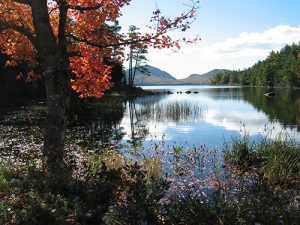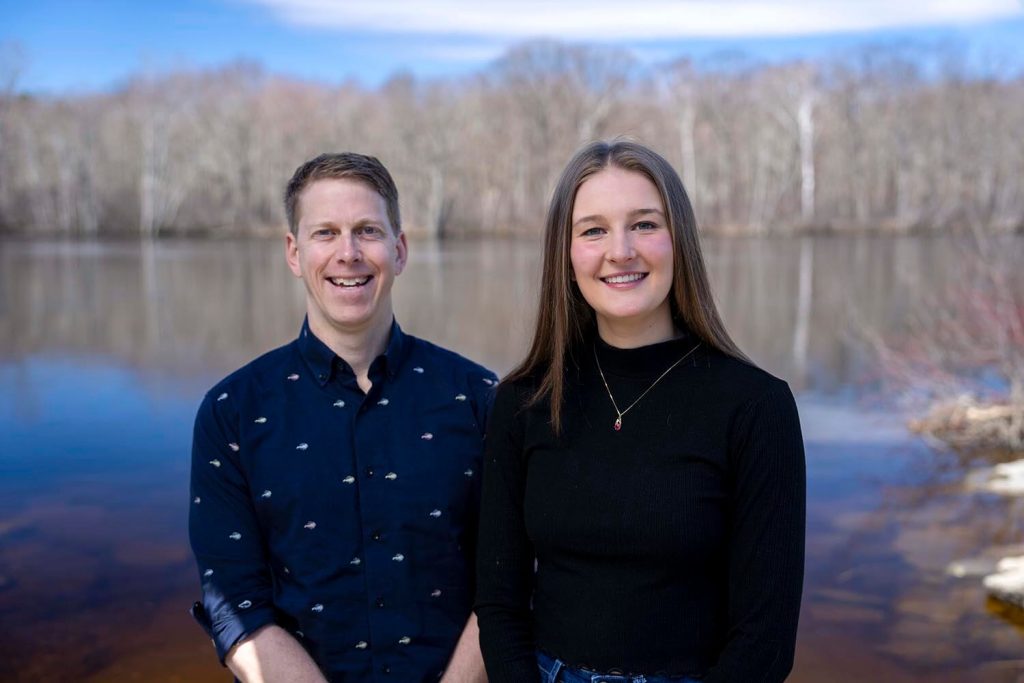Maine lakes are worth $14 billion, according to UMaine study
 Story by Sam Schipani
Story by Sam Schipani
Anyone who has been to a Maine lake can feel their value — its beauty, the rich wildlife, the memories created there — but communicating that value to policy makers when they are deciding where to allocate funds for conservation can be challenging. Thanks to a University of Maine study supported by the Senator George J. Mitchell Center for Sustainability Solutions, advocates for Maine lakes now have a data-backed value for Maine lakes to support their efforts to preserve them: a staggering $14 billion.
The project started when Susan Gallo, executive director of Maine Lakes, met Adam Daigneault, faculty fellow at the Mitchell Center and E.L. Giddings Associate Professor of Forest Policy & Economics, at the Sebago Clean Waters gathering in Windham. Daigneault was presenting on the economic value of forested land in filtering drinking water in southern Maine. In that research, he found that for every dollar spent on forest conservation, there were $8 in benefits to humans between 2018 and 2019.
Gallo thought Daigneault would be the right researcher to update the figures from a 1997 study that organizations like hers had been using to advocate for Maine lakes in the legislature, which valued lakes at around $5 billion at the time.
“We had been using the same numbers adjusted for inflation, but 25 years had gone by and so many things had changed,” Gallo said.
Daigneault thought it was a great project. The study that the original figure was based on, which was also done through UMaine, was cutting-edge for its time. It took a multi-faceted approach to defining “value” of the lakes, looking at both how much people are willing to pay through surveys and calculating the actual monetary transactions that happen along a body of water, from house sales to summer camps. Still, the data were outdated, and the methodology had room for modernization.
Maine Lakes helped him to secure a seed grant from the Outdoor Heritage Fund, and he also received support from the Maine Water Resources Research Institute, a program of the Mitchell Center.
Once he had funding, Daigneault put out the call for a research assistant. He originally planned to hire a graduate student, but when then sophomore Melissa Genoter applied, her enthusiasm for the project won him over. Growing up, she spent summers working for the Youth Conservation Corps at the Friends of the Cobbossee Watershed, and visiting her grandparents’ camp at Maranacook Lake.
“That’s how I fell in love with Maine lakes,” Genoter said. “When I heard about this research assistant position, I was excited to gain research experience in the field I was so passionate about. I was especially lucky to have this opportunity so early on as an undergrad.”
Daigneault and Genoter also teamed up with postdoctoral research associate Jianheng Zhao and Keith Evans, associate professor of marine resource economics, to perfect their methodology and crunch the data.
The team made a few key changes to the 1997 study for their updated version. First, they increased the sample size from 36 lakes to 150 lakes, and expanded the geographic region they studied. They conducted their surveys about lake recreation online instead of surveying people visiting lakes (as the previous study did) in order to capture the reasons that Mainers might not visit lakes. They surveyed 768 Mainers in all.
Once they weighed the value of lakefront properties (compared to similar properties that were not located on the water), recreation for day trips, water consumption and youth camps, the number totaled to a whopping $14 billion.

The researchers also added data collected through the Maine Volunteer Lake Monitoring Program about water clarity — which is, as Genoter said, “the simplest indicator for [water] quality” — to compare against the other information they were gathering, and see if the quality of lake water impacted its value. They found that when it comes to the value of Maine lakes, quality matters. Their surveys indicated even a moderate reduction in water quality would stymie the total annual recreation use value by an estimated $33 million per year.
Genoter emphasized, though, that most Mainers had very positive perceptions about the lakes’ water quality.
“I think it’s important when we’re framing water quality issues to not use scare tactics to suggest that our lakes are degrading quickly,” Genoter said. “It’s like, ‘We already have healthy clean lakes that we’re very proud of. How do we keep them in that state?’”
The results of the study are useful for organizations like Maine Lakes, as well as for the state government departments like the Department of Environmental Protection (DEP), which helped with the data collection for the study.
“As our collaborator at Maine DEP Linda [Bacon] says, an ounce of prevention is worth a pound of cure,” Genoter said. “Investing early in lake protection and conservation is important. A lot of it is just having a number to point to to say, ‘Hey, if you invest in lake protection and conservation, you’re getting that money back.”
Gallo said that thanks to studies like these, the lake protection community has more resources for advocating for their preservation.
“We will definitely be using the economic data as we move ahead with future legislation,” Gallo said. “The numbers generated by this report are already useful. I have sent the preliminary report and fact sheet to lake associations, watershed organizations and individuals. The numbers are already being put in grant reports and requests to towns for funding to illustrate that we are not just protecting water. When we keep lakes clean, we are protecting our economy.”
Daigneault and Genoter both acknowledged that it can be controversial to put an economic number value on natural resources — many people see nature as inherently “priceless,” and putting a price on any aspect of it could be a slippery slope — but note that given the it is one of the best ways to advocate to policymakers for the preservation of natural resources. Gallo has already been able to use the study to advocate for regulations on wake boats which can damage shorelines. She has also developed a decisionmaker document with the information from the study to “distribute far and wide.”
“Any appropriations committee member is obviously looking at money,” Gallo said. “A tool like Adam and Melissa produced is a good thing to have in our pocket. Working with the Mitchell Center team on the lakes economics study has been a wonderful experience for many reasons. Dr. Daigneault and his team were great collaborators, bringing their expertise and modeling skills to the table but also spending lots of time deconstructing their methods so they could be understood by lay audiences. It is, I think, a great example of how to apply academic research, which really does take some extra time and effort.”
Gallo has been collaborating with Genoter to conduct outreach for the study and explain its results to the general public. Genoter and Gallo presented the study on Maine Public’s “Maine Calling” radio program on April 3.
“Academics know their stuff real well. It took me like a month to know what academic economic value really meant. Melissa really helped with that,” Gallo said. “She had this passion for lakes that drove her to do a great job. It’s the progression you really want when you engage young people: you engage them, inspire this passion and they follow this path. She’s delivered presentations and posters and that all by itself is so rewarding that she got involved.”
Genoter and Daigneault will present about the project as keynote speakers at the Maine Lakes and Lake Stewards of Maine Lake Conference 2024 on June 21 at the University of Maine at Farmington.
Genoter said that she can already see ways in which the study can be expanded in the future. She would love to capture other variables which are a little less tangible, like the “existence value” of lakes — research which is currently in progress at Colby College — and incorporate traditional voices into the surveys. Their study also didn’t weigh winter sports as much, — though Daigneault said that the survey indicated that only 5% of people who used Maine lakes did so outside of May to October — so the recreation figures could even be undervalued.
The true value of Maine’s lakes may never be fully captured, but thanks to creative interdisciplinary research and community connections, they have a figure that can be used for their protection today.
